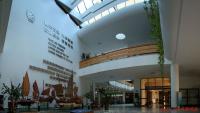Quanzhou Maritime Museum
泉州海外交通史博物馆
Category: Attractions
Address:No.425, Donghu Street
福建省泉州市东湖街425号泉州海外交通史博物馆
Tel: 0595-22100561
0 Likes
About Quanzhou Maritime Museum:
Quanzhou Maritime Museum was created in 1959, and in 1991 some exhibits were moved to a new location. The original location was at the Kaiyuan Temple, and its new location is east of the picturesque East Lake Park. Displays are housed in a structure shaped like a brig (a ship equipped with two full masts), and cover an area of 7,000 sq kilometers (2,703 sq miles). The museum has four exhibition halls: Quanzhou Overseas Communications, Quanzhou Religious Sculpture, Ancient Chinese Sailboats Models, and Quanzhou Customs and Culture. At present, the first three are open to the public.
The Overseas Communications History Exhibition Center showcases a large number of cultural relics and models. The relics well illustrate the vicissitude of the ancient seaport of Quanzhou. The exhibits are divided into four categories, according to the historical events represented, and are displayed in exhibition areas respectively. The exhibits paint a vivid portrait of Quanzhou's overseas trade throughout the past 2,000 years. Highlights include the portrayal of Zhenghe's successful travels to the Indian Ocean, which reflects the prosperity of China's overseas ventures during the Ming Dynasty (1368-1644).
Quanzhou has been a cultural and religious melting pot since ancient times. The Quanzhou Religious Sculpture Exhibition Center testifies to this. The Sculpture Exhibition Center consists of four exhibition areas which display various architectural structures, gravestones and stone tablets related to Islam, Christianity, Hinduism and Manichaeism. Among the artifacts presented, Islamic relics are dominant, ranking first both in terms of quantity and content. These relics indicate that Quanzhou has long been an open city, showing that the Chinese people have always been inclusive and willing to draw on the strengths of various civilizations.
In the Ancient Chinese Sailboats Models Exhibition Center, you will find shipwrecks and models of many ancient vessels. Among the various exhibits, the shipwreck excavated in 1974 from Quanzhou Bay is of great historical significance. It is an oceangoing wooden vessel, built in the 13th century, measuring of 24.2 meters (79.4 feet) in length and 9.2 meters (30.2 feet) in width. The body of the ship consists of 13 watertight compartments. If renovated to its original state, it is estimated that it would stand 34 meters (112 feet) long, and 11 meters (36 feet) wide, and weigh over 200 tons. The relics unearthed in this wreck include spices, medicinal herbs, copper and iron coins, chinaware and pottery. This and other exhibits demonstrate the superb shipbuilding techniques of the ancient Quanzhou people, and the prosperity brought by of overseas trade in ancient times.
As the starting point of the Maritime Silk Road, Quanzhou was the center of overseas trade and other exchanging activities of China in ancient times. The history of Quanzhou is an important part of China's overseas communications legacy, and the Quanzhou Maritime Museum gives an excellent portrayal of the city's sea-faring vicissitude throughout the ages.
The Overseas Communications History Exhibition Center showcases a large number of cultural relics and models. The relics well illustrate the vicissitude of the ancient seaport of Quanzhou. The exhibits are divided into four categories, according to the historical events represented, and are displayed in exhibition areas respectively. The exhibits paint a vivid portrait of Quanzhou's overseas trade throughout the past 2,000 years. Highlights include the portrayal of Zhenghe's successful travels to the Indian Ocean, which reflects the prosperity of China's overseas ventures during the Ming Dynasty (1368-1644).
Quanzhou has been a cultural and religious melting pot since ancient times. The Quanzhou Religious Sculpture Exhibition Center testifies to this. The Sculpture Exhibition Center consists of four exhibition areas which display various architectural structures, gravestones and stone tablets related to Islam, Christianity, Hinduism and Manichaeism. Among the artifacts presented, Islamic relics are dominant, ranking first both in terms of quantity and content. These relics indicate that Quanzhou has long been an open city, showing that the Chinese people have always been inclusive and willing to draw on the strengths of various civilizations.
In the Ancient Chinese Sailboats Models Exhibition Center, you will find shipwrecks and models of many ancient vessels. Among the various exhibits, the shipwreck excavated in 1974 from Quanzhou Bay is of great historical significance. It is an oceangoing wooden vessel, built in the 13th century, measuring of 24.2 meters (79.4 feet) in length and 9.2 meters (30.2 feet) in width. The body of the ship consists of 13 watertight compartments. If renovated to its original state, it is estimated that it would stand 34 meters (112 feet) long, and 11 meters (36 feet) wide, and weigh over 200 tons. The relics unearthed in this wreck include spices, medicinal herbs, copper and iron coins, chinaware and pottery. This and other exhibits demonstrate the superb shipbuilding techniques of the ancient Quanzhou people, and the prosperity brought by of overseas trade in ancient times.
As the starting point of the Maritime Silk Road, Quanzhou was the center of overseas trade and other exchanging activities of China in ancient times. The history of Quanzhou is an important part of China's overseas communications legacy, and the Quanzhou Maritime Museum gives an excellent portrayal of the city's sea-faring vicissitude throughout the ages.
Reviews for Quanzhou Maritime Museum:
If you have been to Quanzhou Maritime Museum? Share your experiences with us!
Sign In to write a review.
Events at Quanzhou Maritime Museum:
No data

